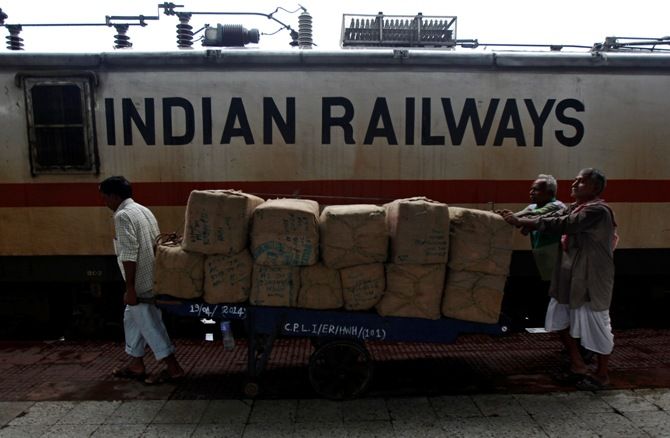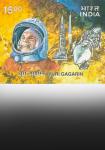 The key to running a successful railway network lies not in standardisation of gauge, but in the interoperability and effective use of technology, notes Bibek Debroy
The key to running a successful railway network lies not in standardisation of gauge, but in the interoperability and effective use of technology, notes Bibek Debroy
This is a clichéd claim that floats around freely, especially on the Net.
The Romans used chariots, yoked to two horses.
The chariots created ruts on the roads.
If a chariot’s width didn’t match the rut exactly, it keeled over. Thus standardisation occurred across all those chariots, measured as the distance between the wheels.
The Romans built roads all over England and replicated those ruts. There were horse-drawn carriages and carts. There were horse-drawn tramways and horse-drawn railways in collieries.
They also stuck to the same width. Thus railways developed the standard gauge of four feet and 8.5 inches (1,435 mm) and the same gauge got transported to the US.
Space shuttles had solid rocket boosters.
Railway tunnels are a fixed percentage wider than tracks and SRBs had to pass through such tunnels.
Therefore, the design of a space shuttle was based on the backsides of two Roman horses.
In several details we needn’t get into, this yarn isn’t true, rollicking good though it might be.
There was no standardisation of gauge across those early British collieries. There was a range from 1,219 mm to 1,524 mm.
Indeed, George Stephenson did base gauge of his Stockton and Darlington Railway on the width of horse-drawn carts used in collieries.
But that gauge was 1,422 mm, not 1,435 mm. He tried out 1,435 mm on Liverpool and Manchester Railway and found that to be better on curves.
Thus the switch to 1,435 mm, but only on railways Stephenson built, and somewhat later.
For invention purposes, I have cited George Stephenson (the father) and Robert Stephenson (the son) almost synonymously and it is difficult to delink the two.
Did you know Robert Stephenson wasn’t quite happy with 1,435 mm?
Left to choose a gauge afresh, he reportedly said, “I would take a few inches more, but a very few.”
Did you know that in 1845, in the UK, there was a Royal Commission on Railway Gauges?
This led to a Gauge Act.
There were too many gauges floating around: 1,435 mm, 2,134 mm and narrow gauges.
But there was still incomplete standardisation, in the UK and the US.
For instance, in the US, there was greater standardisation in the north than the south and this inefficiency in managing railway networks was cited as a reason for the Confederacy’s defeat.
If one leaves narrow and metre gauge aside, there is standard gauge (1,435 mm) and broad gauge. But broad gauge also differs across countries.
Ours may be 1,676 mm, but the range across countries varies from 1,520 mm to 2,140 mm. There were differences within Europe too, and the European Union (EU) struggled quite a bit with gauge unification.
India had its own battle over gauges.
Both Lord Dalhousie and F W Simms, the consulting engineer for East India Company, wanted a gauge broader than 1,435 mm. Lord Dalhousie wanted 1,829 mm and Simms favoured 1,676 mm.
Why couldn’t India have adhered to 1,435 mm?
East India Company directors had a curious worry: “the continued action of violent winds, and the influence of the vertical sun”.
These climatic conditions would make 1,435 mm unsuitable.
Despite Lord Dalhousie’s preference for a uniform gauge, that didn’t materialise. Primarily because of lower costs, narrow and metre gauge proliferated.
I read an apocryphal account of how Lord Mayo made three Indian males sit next to each other, measured the distance and thus decided the metre gauge width. But this account is probably of the same genre as the one of Roman horses.
Under the Indian Railways’ plan of gauge conversion, Project Unigauge, all narrow and metre gauge lines are being converted to broad gauge.
However, this still makes India an outlier, in the sense that several countries have standard gauge (1,435 mm).
Standard gauge makes acquisition of rolling stock and related stuff easier, which is why Metro railways have standard gauge, not broad gauge.
Dedicated freight corridors also operate on broad gauge.
The heights/weights of wagons are more than those of conventional lines, but the gauge is identical.
Train lengths, train loads, axle loads and maximum speeds are also more along freight corridors. On gauge, as was Lord Dalhousie’s intention, the Indian Railways’ desire has always been for interoperability and standardisation.
Despite Lord Dalhousie, several different gauges existed. If all mobile phones had similar chargers, life might be simpler.
But the different Indian Metro railways seem to function satisfactorily with completely different kinds of power systems, without standardisation.
Despite unification of gauge, the EU discovered interoperability becomes impossible because of differences in rolling stock and signalling, controlling and telecommunication systems.
These are all integrated systems, with gauge only one of the components.
As systems, they represent technology, characterised by intellectual property rights and developed independently. Perhaps there is an analogy with the way the Indian Railway Conference Association was formed in 1903, later transforming into the Research Designs & Standards Organisation.
Anything like the IRCA, developed through industry bodies, focuses on coordination.
But something like the RDSO focuses on control and standardisation. Standardisation and uniformity may or may not have had a role when the IR was a closed system.
However, as the IR opens up, we need to recognise railway technology only exists in a few countries and these aren’t interoperable.
Image: Porters transport goods on a hand-pulled trolley to load onto a train at a railway station in Kolkata. Photograph: Rupak De Chowdhuri/Reuters
Bibek Debroy is a member of the National Institution for Transforming India Aayog. The views are personal










 © 2025
© 2025